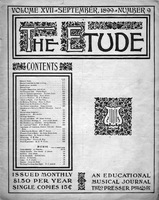By Clara A. Korn
In these days of keen competition between music-teachers it appears that the one idea that has taken deep root in the minds of instructors is that they must become known as the expounders of some particular method. Naturally, there is some reason in this fallacy, as the public seems to believe as firmly in the necessity for a certain musical method as in the prevailing fashions in dress; therefore the helpless music-teacher, whose sustenance depends on his earnings, is compelled to pamper to the preference of that public. Of course, to be just, there are many teachers who themselves entertain the greatest confidence in their own method and are perfectly honest in their proclamations.
But let it be said that one specific method in pianoforte playing or in vocal culture will no more fit each and every individual than will one certain combination of clothes. In this I am reminded most forcefully of a little fat woman who recently afforded me a merry five minutes. She was determined to be up-to-date in style, and had therefore instructed her dressmaker to procure the most recent Parisian design for her benefit. Now, unfortunately for the little fat woman, this design consisted of a very wide skirt, interrupted midway by a voluminous accordion-pleated flounce. The modiste entertained conscientious scruples, be it said to her credit, but the little fat woman would have it. Nothing could have presented a more preposterous spectacle than the little fat woman when she appeared all attired in this, her newest finery; for, not content with the flounced skirt alone, she had augmented the ludicrous effect by a wavy, bead-betrimmed cape and a gigantic plumed hat. And this on a corpulent person, five feet in height!
And so it is with pianoforte methods. Long, lanky pupils have been known to struggle unsuccessfully with the low-stool position on which their teachers insisted, and short, pudgy students have almost cracked their spines in their vain endeavors to comfortably reach the keys from an excessively high perch. Some methods proclaim crooked fingers the only safe road to virtuosity; other methods condemn all and any position except that produced by almost straight joints; some advise the swoop, others the clutch; some the low hands, some the high hands.
Now, it seems to me that, while conceding that some carefully devised method must form the basis of all instruction, it is carrying a point too far to insist on its rigid enforcement in every individual. Two things are absolutely essential to the production of an artist—ease and freedom from affectation. If the performer be uncomfortably seated, or cramped in the arm by a too serious adherence to the dictates of the method, it stands to reason that his playing will also be cramped and forced, and the impossibility of producing a good tone is self evident. Then, too, we are frequently pained by the spectacle of pianists whose main ambition seems to be to make the most uncouth bodily gyrations possible in the human form. Should it at any time become necessary for a pianist to render a program seated out of sight behind an upright piano, the assembled audience will unquestionably be content to hear the music, without seeing the hands flying periodically over the top of the instrument. Again, every audience is more attentive when the player sits firmly on the piano stool, and, therefore, all wobbling, struggling, twisting, and wriggling on the part of the performer detract from the enjoyment of the performance. Perhaps (who knows?) this sort of pianist is himself so sure of his shortcomings on the artistic side that he deems this physical exhibition necessary.
Now, strange as it may seem, there are some European conservatories which approve of this body-distorting, hand-throwing method, and, far from reprimanding their pupils for these misdeeds, encourage them to become rubber pianists instead of genuine music-producing artists.
In vocal tuition, too, many sins are committed. I am assured by responsible parties that more charlatanism exists in this line of work than in any other; and while I am not prepared personally to vouch for this accusation, I am convinced by observation that it contains much truth. It is enough to insist on proper breathing, good diction, fine technic, the production of the best possible tone, etc., without devoting months to wearing out the abdominal muscles, to cultivating distortions of body and visage, and to splitting up languages into fragments and ruins, to the like of which the mummies of ancient times are models of Grecian statuary. If the public could only be trained to follow the dictates of reason, and not blindly trample in the paths of sensationalism; if it could realize that method tempered with judgment, and not method alone, is the panacea for artistic greatness, we might have more unspoiled talents, fewer ruined voices and constitutions, more pianists the sight and sound of whom are alike a delight and an education.



